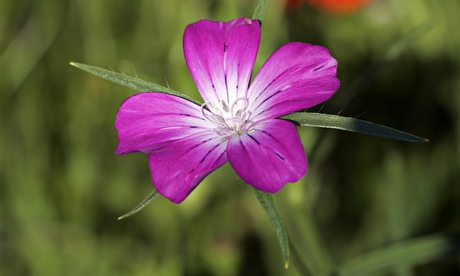
What a corncockle up. In a classic summer scare story, the Telegraph has accused the BBC of spreading poison across the land after Countryfile offered viewers free packets of wild flower seeds via the Grow Wild project run by Royal Botanic Gardens Kew.
These included seeds of the corncockle, a rare wild flower that is pretty, and also poisonous. You’ll find claims on the internet that it causes severe stomach pain, vomiting and even death. In Royal Wootton Bassett, the town council has hurriedly fenced off and cut corncockle flowers planted by local Brownies in a park after a resident reported the terrifying spectre of a tiny purple flower.
This kerfuffle is a huge overreaction, given that many of our most popular garden plants are poisonous, including daffodils, laurel, ivy, yew, hellebores, lupins and particularly foxgloves. In fact, we have lived alongside poisonous plants for centuries, and many toxic species are particularly useful to medicine and are used in life-saving drugs. Even parts of plants we eat, such as potatoes, are toxic.
“It’s like the Jerry Maguire show-me-the-money test – for me, it’s show me the bodies,” says John Robertson, author of a guide to poisonous plants memorably called Is That Cat Dead? “If you’re going to say a plant is really dangerous, show me the dead people.”
According to Robertson, there are “absolutely no records” of the corncockle – also known as “bastard nigella” – doing anyone any serious harm. “It is only poisonous if you eat it and there’s absolutely nothing about the corncockle that’s going to encourage you to eat it.”
Monique Simmonds, head of Kew’s Sustainable Uses of Plants group, says that the corncockle does contain compounds that can be toxic but only if eaten in large amounts. “The toxic compounds are in higher concentrations in the seeds, which are hard and very bitter. If eaten by a child, the child would most likely be sick or complain of a stomach ache. There is no evidence that eating a few seeds would cause acute toxicity.”
Trevor Dines, botanical specialist at the charity Plantlife, is dismayed by the scaremongering over one of our rarest plants, which has been reduced to just one site in the wild and so has been included in wild flower seed mixes (without incident) for years.
“We shouldn’t demonise our wild plants like this. Corncockle is one of a group of the most threatened plants in Britain – our corn field flowers. We should cherish them and relish the opportunity to give them back to the countryside.”
There is a forest of careful advice about poisonous plants but the best is a comment from a sensible reader of the Swindon Advertiser’s corncockle story. “We used to have a laburnum tree that hung over from a neighbour’s garden when I was a kid, that dropped seed pods into ours,” writes JC. “Our dad said, ‘Don’t put them in your mouth, they’re poisonous,’ so we didn’t. Sorted.”

